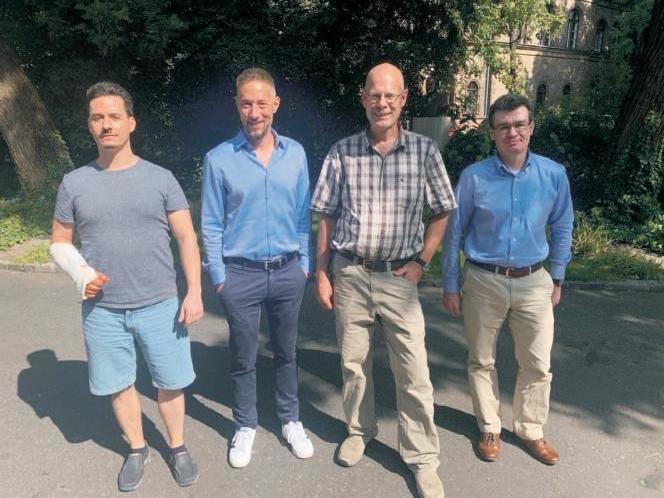UNIVET
Prof. Péter Nagy, head of redox biology research team
interwiev
Research and education go hand in hand We interviewed Prof. Péter Nagy, scientific director of the National Institute of Oncology, newlyappointed professor of the University of Veterinary Medicine Budapest and head of its redox biology research team. We asked him about the new cooperation as well as the hardships and beauty of being a researcher. ALEXANDRA BULEJKA – You are involved in a special area of basic oncology research called redox biology. Please tell us about your work. – Redox biology basically studies the physiological roles of oxidation processes. These processes have a key role in tumour progression, i.e., in the advancement of cancer as well as in metastasis formation. We also study t h e r e s i s t a n c e m e ch a n i s m s developing in response to various treatments. Cancer cells have a special trait: they produce much more oxidatives than normal cells, which affects the control of the different proteins. Proteins are key factors in the biological processes of cells. The various intracellular signal transmission processes are conducted by proteins, whose reprogramming along the oxidative processes forms an important element of tumour progression. That's what we study. – How is the University of Veterinary Medicine Budapest related to this research? – Rector Prof. Péter Sótonyi lays great emphasis on strengthening the university's scientific activities, that's how I was brought in the picture. In our scientific work, we use special animal models which we currently produce partly in our own laboratory and partly in Professor Edward E. Schmidt's lab at the University of Montana. Thanks to Rector Prof. Péter Sótonyi and Vice Rector for Science and Research Dr. Ákos
30
Jerzsele, the UVMB will also use our scientific programme and the animal models we apply and develop, so we can be even more effective in our research in the future. We can also raise our collaboration with Professor Schmidt to a higher level, since the cooperation allows him to work at the UVMB in 20% of his time, which is a great achievement. We got a sensational opportunity from the University: we can use a practically finished, modern and wellequipped lab. They acquired the key instruments we need, and we got a section in the animal house to store and develop our animal models. The two heads of the research team will use the lab together, and we added two new colleagues to the team to support our work. We are offered a great opportunity and we want to make the most of it together. – You mentioned you use special animal models. How do you decide which animal to use for your research? – At present, we mostly use mice for our scientific activities. They are small and relatively efficient to work with. We apply modern, 21st-century technologies in our research. They are cost-intensive, so working with small animals makes it more cost-effective. Certain scientific activities require other animal models as well. For example, as far as Covid is concerned, the anti-SARS-CoV2 vaccine development project (in the likely scenario that we reach the level of developing animal models at some point) will no longer use mice, because their immune system is vastly different from humans. Mouse models are just not quite suitable for certain processes. – I assume the results of the UVMBhosted project will affect the human area as well.
– Yes, that's part of the reason why we want to form a strong professional relationship between the National Institute of Oncology and the UVMB. In Hungary, the National Institute of Oncology is the stronghold of oncological care and science; lots of operations take place here, so we often work with human samples as well. The UVMB-hosted project will primary involve animal models, but these scientific activities are naturally interrelated. If you want to develop medicine efficiently, you must go down to the cellular level. In fact, you might even need to break down the processes to enzymes. We have a couple of drug candidates that we can launch in the pre-clinical trials. This will also be conducted as part of our collaboration with the UVMB. Dr. Zoltán Vincze, the head of the chemistry department helps us in this regard. – How should we imagine the work of the research team? What's your typical day like? – The work of a researcher is highly diverse: beside the laboratory tasks, it also involves a lot of writing, such as articles and grant applications. The various projects require a certain series of activities and tasks in progression. We come up with an idea how a problem could be solved. We design it, we carry out new experiments, for which we learn new methods in fact, sometimes we invent new methods. Then we publish. The scientific results must be published in the professional journals, after undergoing a complicated and rigorous reviewing procedure. Criticisms must be addressed, sometimes new experiments must be conducted to validate claims. So we're talking about a quite long and timeconsuming process here. Of course, we have some routine tasks, too: keep
2021 III.















